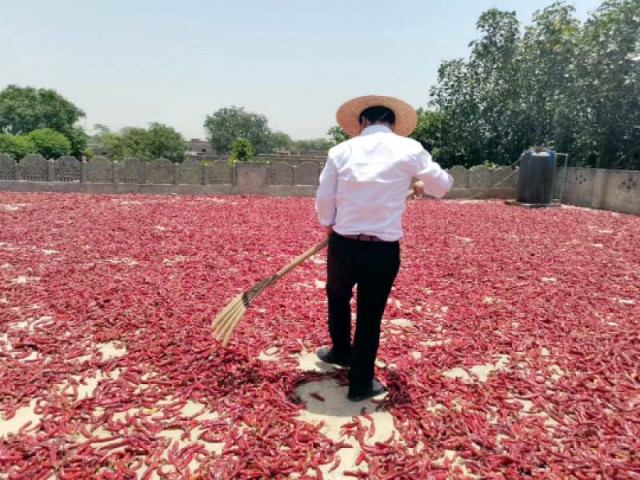Pakistani chilli to spice up China
With Chinese assistance, 300 tons of chilli has been cultivated in Lahore

Soaked in summer sun, 300 tons of chilli glows softly in the pilot chilli field in Lahore. “The 300 tons of chilli we picked will be dried and exported to China in August,” noted China Machinery Engineering Corporation (CMEC) Pakistan Subsidiary General Manager Wu Guang, adding that it is the first time Pakistani chilli will enter the Chinese market since 2020.
What happened to Pakistani chilli?
Pakistan has ideal conditions for chilli/pepper cultivation. According to Food and Agriculture Organisation of the United Nations (FAO), Pakistan is amongst the top 10 chilli producing nations which enjoy a combination of warm, humid yet dry weather and a well-drained sandy loam with rich organic content.
However, Pakistan’s chilli production has been lower than the world average for the same period since 2015. From FY14-15 to FY17-18, the average annual production of chilli in Pakistan was around 143,428 tons, but it plummeted to 126,943 tons in FY18-19, accounting for 85.7% its peak in FY17-18 of 148,114 tons.
For example, Sindh province is the major producer of chilli followed by Punjab and Balochistan. The major constraints in production faced by chilli farmers here are lack of modern irrigation system, imbalance in use of fertiliser and pesticide, and lack of training.
“In Pakistan old methods of 1970s or 1980s are adopted by farmers. Now Pakistan has to adopt modern technology to increase its production,” recommended Special Investigative Correspondent in Pakistan Zahid Gishkori.
What is worse is growers are troubled by some marketing issues, including unreasonable commission agent charges, improper weighing, price fluctuations and lack of proper storage facilities. Pepper growers are unable to make a proper profit from chilli due to marketing channel barriers.
Talking to China Economic Net, Fatima AG Solutions Limited Director Marketing Khurram Javed Maqbool pointed out that at present the whole ecosystem in Pakistan is inefficient. “From harvesting to sewing and storing of the crop and then selling it and then farmers getting financing and then the returns for their produce...all these operations require improvement.”
Pak-China cooperation
In July, a pilot chilli farm project under the cooperation between Pakistani farmers and their Chinese partners - CMEC and Sichuan Litong Food Group - began to bear fruit, with a yield around three times Pakistani varieties.
Sichuan Litong Food Group, China, Chairman Chen Changwei noted that their pilot chilli farm project successfully completed 100 acres of plantation in the first half of 2021 in Lahore. For the 100-acre-pilot-project, the quantities of seeds are 380 grams per acre, with a yield reaching three tons per acre. The total production is expected to reach 300 tons.
While as per Ministry of National Food Security and Research (Economic Wing), chilli is grown on 47,349 hectares in Pakistan with a crop yield of about 2.68 tons per hectare (1.072 tons per acre) and an annual production of around 126,943 tons in FY2018-19.
Why did the production increase?
Seed matters. As per Chen, they brought a total of 13 varieties of Chinese chillies to Pakistan since 2019. It took them three years to conduct the pilot programme, and of all these 13 varieties, two varieties, namely, PJH-302 and PJH-407, have been certified for cultivation in Pakistan.
“Seed is the basic input for agriculture sector and has imperative role in enhancing agriculture productivity, food security and poverty alleviation,” said Year Book 2019-20 released by Ministry of National Food Security and Research, Pakistan.
On top of seeds, field management is also of great significance. Correct and careful management of farming and farmers could increase efficiency and reduce risk.
“We will arrange a team of three agricultural experts on each chilli field of around 0.165 acres,” Wu Guang told China Economic Net. And these agricultural experts will train Pakistani staff in planting technology.
Advanced Chinese irrigation systems have also been introduced into the field. Umer Diyal, a farmer who worked in the pilot Chilli farm in Qasbi, Lahore, said that the Chinese introduced an irrigation system, and the expense of fertiliser has been reduced and every plant was getting water. “Watering of plants is not complex and expensive anymore,” he added.
Also, contract farming helps a lot when it comes to addressing farmers’ concerns about marketing.
Agriculture-related economy is vulnerable, so “we are conducting contract farming with Pakistani farmers,” Guang told China Economic Net. That is, Pakistani farmers undertake to supply agreed quantities of chilli, based on the quality standards and delivery requirements of CMEC. In return, CMEC agrees to buy the chilli, at a price that is nailed down in advance.
“When the chillies are ripe, they are naturally dried and then shipped back to China for further processing,” Chen Changwei noted.
Chinese Ambassador to Pakistan Nong Rong praised the chilli farming project, saying that the project is expected to produce more than 8,000 tons of dried chillies with a net income of more than Rs100,000 per acre for local farmers.
THIS ARTICLE ORGINALLY APPEARED ON CHINA ECONOMIC NET
Published in The Express Tribune, July 18th, 2021.
Like Business on Facebook, follow @TribuneBiz on Twitter to stay informed and join in the conversation.



















COMMENTS
Comments are moderated and generally will be posted if they are on-topic and not abusive.
For more information, please see our Comments FAQ